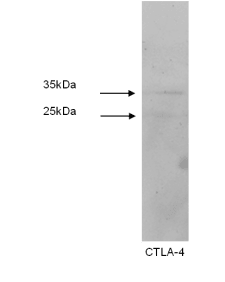Anti-sCTLA4 [L4P2F5*F10]
Invented by Ayham Alnabulsi from Vertebrate Antibodies Limited
Invented at Vertebrate Antibodies Limited
- Datasheet
- References (0)
- Inventor Info
Info
| Catalogue Number | 152604 |
| Applications | ELISA IHC WB |
| Antigen/Gene or Protein Targets | Cytotoxic T-lymphocyte-associated protein 4, sCTLA4 molecule (sCTLA4 soluble form) |
| Synonyms | Cytotoxic T-Lymphocyte Associated Protein 4; Insulin-Dependent Diabetes Mellitus 12; Celiac Disease 3; CTLA-4; CD152; CD152 Antigen; CELIAC3; IDDM12; ALPS5; GRD4; GSE; CD |
| Reactivity | Bovine, Human, Mouse and Rat |
| Relevance |
CTLA4 (Cytotoxic T-Lymphocyte Antigen 4), also known as CD152, is a protein that plays an important regulatory role in the immune system. CTLA4 is expressed on the surface of Helper T cells and transmits an inhibitory signal to T cells. Mutations in the CTLA4 gene have been associated with various autoimmune diseases, such as systemic lupus erythematosus, insulin-dependent diabetes mellitus, and other autoimmune diseases. A recently identified novel transcript of the CTLA-4 gene that may represent a native soluble form of CTLA-4 (sCTLA-4) showed that eleven of twenty patients with autoimmune thyroid disease (ATD ) had a high concentration of sCTLA-4, whereas only 1 of 30 apparently healthy volunteers contained measurable levels. sCTLA-4 immunoreactivity was inhibited by its binding to B7.1, suggesting that sCTLA-4 is a functional receptor. sCTLA4 also plays a role in the initial immune response to infection of immune cells by HIV, along with the CD-1 pathway and others. There is strong evidence showing variation of sCTLA4 levels between individuals ranging from approximately 150 to around 10,000 pg/ ml. One can speculate that those patients with high sCTLA4 levels are unlikely to benefit from CTLA4 therapy. Hence, it is crucial to measure/ quantify sCTLA4 before administering treatment. This anti-sCTLA4 antibody could prove a useful predictive biomarker. |
| Host | Mouse |
| Immunogen | Ovalbumin-conjugated synthetic peptide CENAPNRARM |
| Positive Control | IHC- formalin-fixed, paraffin-embedded multi tumour tissue microarray; WB - Jurkat cell lysates |
| Subclass | IgG1 kappa |
| Notes | Immunogen sequence is identical to mouse (Mus musculus), rat (Rattus norvegicus) and bovine (Bos taurus). |
| Research Area | Immunology, Stem Cell Biology |
References
There are 0 reference entries for this reagent.
References: 0 entry
There is no reference for this reagent yet, feel free to use the button below to suggest one.
Add a reference
References: 0 entry
There is no reference for this reagent yet, feel free to use the button below to suggest one.
Add a reference



![A. Immunohistochemical staining of formalin-fixed, paraffin-embedded human lymph node using anti-sCTLA44 [L4P2F5*F10]. Cytoplasmic staining is shown as expected (CTLA4 is expressed in T-cells).
B. Positive cytoplasmic staining was also detected in human breast cancer sections.](https://res.cloudinary.com/ximbio/image/upload/c_limit,fl_lossy,h_282,q_auto,w_368/10f001f4-9d8c-43ad-ac84-21db7da32b88.jpg)
![Anti-sCTLA4 antibody [L4P2F5*F10] was applied to detect soluble CTLA4 in mouse serum by indirect ELISA.](https://res.cloudinary.com/ximbio/image/upload/c_limit,fl_lossy,h_282,q_auto,w_368/3c635b3a-a2c0-4ceb-86c9-2aab5e040bf6.jpg)
![Image thumbnail for Anti-sCTLA4 [L4P2F5*F10]](https://res.cloudinary.com/ximbio/image/upload/c_fit,fl_lossy,q_auto/98594e79-c91e-4eb6-ba26-2de4245137bb.png)
![Image thumbnail for Anti-sCTLA4 [L4P2F5*F10]](https://res.cloudinary.com/ximbio/image/upload/c_fit,fl_lossy,q_auto/10f001f4-9d8c-43ad-ac84-21db7da32b88.jpg)
![Image thumbnail for Anti-sCTLA4 [L4P2F5*F10]](https://res.cloudinary.com/ximbio/image/upload/c_fit,fl_lossy,q_auto/3c635b3a-a2c0-4ceb-86c9-2aab5e040bf6.jpg)
![Image thumbnail for Anti-sCTLA4 [L4P2F5*F10]](https://res.cloudinary.com/ximbio/image/upload/c_fit,fl_lossy,h_45,q_auto/98594e79-c91e-4eb6-ba26-2de4245137bb.png)
![Image thumbnail for Anti-sCTLA4 [L4P2F5*F10]](https://res.cloudinary.com/ximbio/image/upload/c_fit,fl_lossy,h_45,q_auto/10f001f4-9d8c-43ad-ac84-21db7da32b88.jpg)
![Image thumbnail for Anti-sCTLA4 [L4P2F5*F10]](https://res.cloudinary.com/ximbio/image/upload/c_fit,fl_lossy,h_45,q_auto/3c635b3a-a2c0-4ceb-86c9-2aab5e040bf6.jpg)

